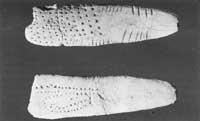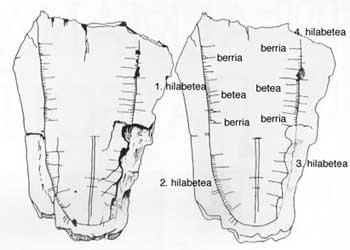Paleolithic calendars
Some of these remains related to astronomy were found near Euskal Herria. In the Vézère River basin, in the Aquitaine region of Périgord, prehistoric sites abound around Les Euzies de Tayae. The well-known Madeleine and Lescaux coats are located in this area. Some of the instruments and works found in these deposits are those that, as a result of exhaustive research, have been equated to some type of calendar, the simple calendars based on the Moon. Among them are Palaeolithic remains, or more specifically the Upper Palaeolithic (35,000-10,000 BC). Periodicals.

In some bones found in Abri Lartef long cutting sequences have been found organized into groups of 29 or 30 repeated signs. Undoubtedly these sets of piers are related to the days of the moon. Extensive studies also performed under the microscope show that notches have been repeated times, as days would be counted in repetitive cycles. This is the case, for example, of another Aurignac bone discovered in Abri Blanchard. The bone is believed to be C. This is a work carried out around the year 30,000 and in it appear 69 cuts made with 24 different tools. In most cases, the harvests in the bone have the shape of the lunar phase they want to express.
A. The American archaeologist Mashack is the pioneer in the study of the bones mentioned. Do not forget that the bones found in Dordonia are not the only ones with the particularities exposed. They are of the oldest, but toothed bones of similar meaning have been found throughout the Earth. In fact, the first who studied Mashack was a bone found in equatorial Africa, in the village of Ishan, near Lake Tuskana. The latter is after the previous ones; that of the Mesolite (a. C.) 8.500). On three sides of this bone you can see 168 notches spread over 16 groups. Therefore, they would indicate more than five and a half months and the intervals between the different groups would indicate the days corresponding to the phases of the Moon, that is, the full moon, the waning moon, the new moon and the days of the crescent moon.
Other bones found in the village of Gontzi of Ukraine also seem designed for the follow-up of the phases of the Moon. Another is another bone discovered in the Czech town of Kulna. It has three groups of 15, 16 and 15 quotes, that is, they represent half of the month. It is clear, then, that the Mashack hypothesis that all the efforts described are programs that respond to the need to measure time and organize basic calendars is the most credible. It seems logical that for these works the Moon is taken as a reference, since tracking our satellite only requires looking directly at the kneading. In addition, the month is more appropriate to control the succession of seasons than the day and may be enough until more difficult Sun movements are detected.
It is also evident that these needs have been generated in all territories and cultures. However, it is more difficult to determine the causes of these needs. Did hunters use them to count the days or the moon they made outside? Or was it to keep track of the days that were missing for birth? With the data we currently have it is absolutely impossible to answer these questions. We need clues and research to provide more information.

Ephemeris SUN: April 20 at 7h 26min (UT) enters Taurus.
THE MERCURY PLANETS: we can see it in the first days, at dawn, but in very difficult conditions. Day 30 will be in superior conjunction (invisible). VENUS: It appears higher and higher on our finger when hiding the Sun. So every time we have better to see it. MARTITZ: it appears at dawn, but with very little time and in bad conditions to see it. JUPITER: at the beginning of the month it leaves after dusk, but from the center the Sun disappears on the horizon by the East, crossing the kneading throughout the night. SATURN: it leaves at dawn, from the middle of the month before dawn light appears, but it is still very low to be able to see it properly. |





